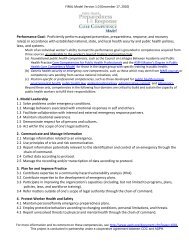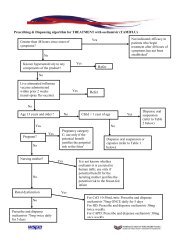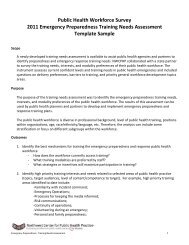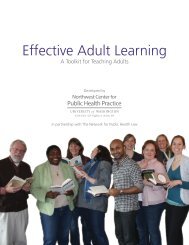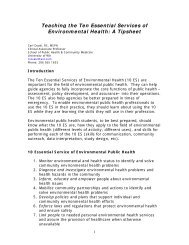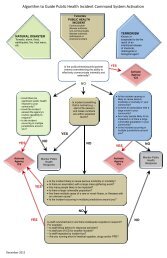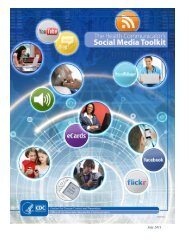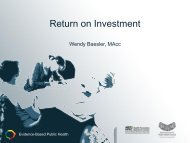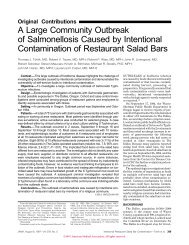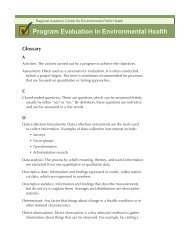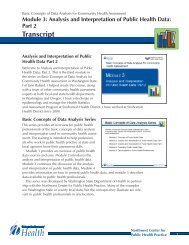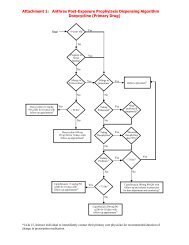Effective Presentations - Northwest Center for Public Health Practice
Effective Presentations - Northwest Center for Public Health Practice
Effective Presentations - Northwest Center for Public Health Practice
You also want an ePaper? Increase the reach of your titles
YUMPU automatically turns print PDFs into web optimized ePapers that Google loves.
2. How Do I Speak <strong>Effective</strong>ly?<br />
What are some of the elements of speaking?<br />
Pacing: Determine how you want to pace your<br />
presentations. <strong>Effective</strong> presentations can be set to<br />
a quick pace, a calm pace, or a combination. But<br />
be deliberate. Think about your audience, content,<br />
and your personality. Regardless of what you<br />
choose, practice. Say the presentation out loud so<br />
you know that the material fits in the allotted time.<br />
Ask someone to listen to at least part of it to make<br />
sure that you are not speaking too quickly to be<br />
understood.<br />
Clarity: Make sure that you can be heard by<br />
everyone in the room. The volume and clarity of<br />
your voice is essential. Check to see if you need<br />
amplification or other technology. And we all change<br />
our delivery when we get nervous, so be careful to<br />
speak clearly and enunciate.<br />
Cadence: Do not read your presentation. Being<br />
well-prepared and speaking conversationally will<br />
make your sentence style easier to understand.<br />
Speaking naturally uses traditional conversation<br />
techniques of pauses, emphasis, rhythms, and<br />
pitch. If you’re giving your presentation in-person,<br />
speaking (instead of reading) also allows eye contact,<br />
a primary way to connect with your audience.<br />
What if my presentation is in-person?<br />
Everyone has felt that moment of intimidation be<strong>for</strong>e<br />
stepping in front of an audience, no matter how large or<br />
small. <strong>Public</strong> speaking is a skill people have been trying<br />
to hone since grade school, but it can still be a challenge.<br />
Prepare <strong>for</strong> the presentation by carefully thinking<br />
through your material and any accompanying visuals. The<br />
more familiar you are with your presentation, the more<br />
com<strong>for</strong>table and confident you’ll be when speaking in front<br />
of others.<br />
Key Components<br />
• Elements of speaking<br />
• In-person presentations<br />
• Distance-based<br />
presentations<br />
Speaking Tips<br />
Pacing<br />
Quick, calm, or a<br />
combination, but be<br />
deliberate and practice.<br />
Clarity<br />
Check your volume and<br />
enunciate.<br />
Cadence<br />
Don’t read, speak<br />
conversationally which<br />
naturally introduces<br />
pauses, emphasis,<br />
rhythms, and pitch.<br />
Maximize audience engagement. You’ve already started<br />
to pave the way <strong>for</strong> this with your audience research,<br />
customizing your content with applicable, relevant examples.<br />
www.nwcphp.org <strong>Effective</strong> <strong>Presentations</strong>: A Toolkit <strong>for</strong> Engaging Audiences | 8




